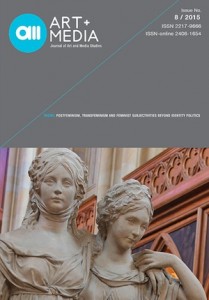 The Editorial Board of AM: Journal of Art and Media Studies invites all potential contributors to send their proposals for issue No. 12/2017. AM is structured in five sections: Discussions, Research, Artist Portfolio, Studies, and Book Reviews. Only the first section, which is also the central one – Discussions – is predefined by the main topic of the issue. The Research and Studies sections are intended for scholarly articles dedicated to various freely chosen theoretical problems of contemporary art and media (see Author Guidelines).
The Editorial Board of AM: Journal of Art and Media Studies invites all potential contributors to send their proposals for issue No. 12/2017. AM is structured in five sections: Discussions, Research, Artist Portfolio, Studies, and Book Reviews. Only the first section, which is also the central one – Discussions – is predefined by the main topic of the issue. The Research and Studies sections are intended for scholarly articles dedicated to various freely chosen theoretical problems of contemporary art and media (see Author Guidelines).
The topic of the Discussions section in issue No. 12/2017 is Architecture with(in) Art and Theory. Looking back at high modernist art theories, we might recall Clement Greenberg’s well-known view that experience precedes theory. Apart from advocating certain formalist solutions as more acceptable than others, this claim also postulated a sort of model for making and observing art. Among Greenberg’s many, undoubtedly complex premises, there were two significant implications that – in terms of autonomy – defined poetic relations between different artistic disciplines and theoretical relations between art and society. When neo-avant-garde practices challenged this kind of modernist aesthetic hermeticism, it opened experimental and in-between space for work, while art retrieved – once again, after the historical avant-gardes – its ability to make critical commentary on the disciplinary conditions and society in general. As a result, medium-specific art was widely replaced by mixed-media art, which was welcomed and assimilated by pluralist and postmodern theories.
The topic of this issue is to examine the role of architecture in this art-theory complex. The reference to Greenberg should be (just) a metaphor for a similar, but by no means identical process in architectural discourse. In architectural terms, this story goes something like this: in its (hermetic and, conditionally speaking, autonomous) domain of engineering, technology, and ergonomics, high-modernist architecture was largely disconnected from the other arts and theory.
Still, some theories, such as rationalism, positivism, pragmatism, functionalism, and behaviorism appeared in architecture from time to time, and the formalist language of avant-garde abstraction remained. After decades spent in its modernist enclosure, the postmodern era saw the opening of architectural discourse to the contamination of art and theory. During the late 1960s and 1970s, the first wave of postmodernism introduced leftist strains from structuralism and phenomenology as a means of building a theory around a privileged architectural object. In the mid 1980s, the second wave of postmodernism showed a desire for artistry in architectural practice, as well as generated some sophisticated readings in theory. Literary genres (dirty realism and cyberpunk), sculpture in an expanded field (minimal art and land art), ambient art, performance and so on, became topics in architectural projects, while the critical cutting edge of postmodern hermeneutics (Weak Thought) and poststructuralism (deconstruction) became embodied in the domain of interpreting architecture.
We are looking for papers that might theorize different historical and contemporary models of making and thinking architecture outside the framework of its own discipline, emphasizing interaction with the domains of other arts and theory, positing those interactions in a broader social context.
Please submit your paper topic, an abstract of up to 250 words, and a short biography (about 100 words) by e-mail to amjournal@outlook.com by 1 October 2016, and the final version of your paper by 31 December 2016 at the latest.
You will be notified by 15 October 2016 if your topic has been accepted.
Contact Info: amjournal@outlook.com

Leave a Reply
You must be logged in to post a comment.